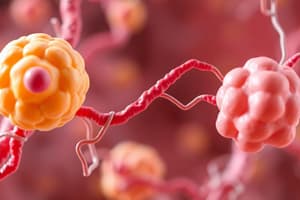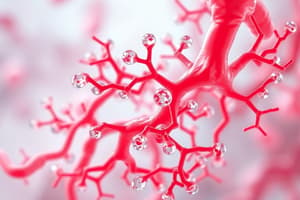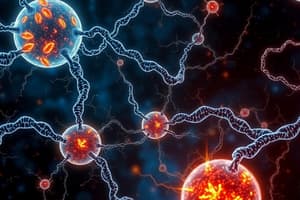Podcast
Questions and Answers
Which substrates are primarily used in gluconeogenesis?
Which substrates are primarily used in gluconeogenesis?
- Fatty acids and glucose
- Acetyl-CoA and ketone bodies
- Lactate, pyruvate, glycerol, and α-keto acids (correct)
- Glucogenic and ketogenic amino acids
What is the primary organ responsible for gluconeogenesis during an overnight fast?
What is the primary organ responsible for gluconeogenesis during an overnight fast?
- Adipose tissue
- Muscles
- Liver (correct)
- Kidneys
How does the contribution of kidneys to gluconeogenesis change during prolonged fasting?
How does the contribution of kidneys to gluconeogenesis change during prolonged fasting?
- It becomes the exclusive source of glucose
- It increases to approximately 40% (correct)
- It decreases to 10% of total production
- It remains constant at 10%
Which of the following is a major regulating substance for the gluconeogenesis process?
Which of the following is a major regulating substance for the gluconeogenesis process?
What is primarily responsible for the release of lactate into the bloodstream?
What is primarily responsible for the release of lactate into the bloodstream?
What role does lactate play in the process of gluconeogenesis?
What role does lactate play in the process of gluconeogenesis?
Which enzyme is primarily activated by glucagon to stimulate gluconeogenesis?
Which enzyme is primarily activated by glucagon to stimulate gluconeogenesis?
What effect does acetyl CoA have on gluconeogenesis during fasting?
What effect does acetyl CoA have on gluconeogenesis during fasting?
How does insulin influence gluconeogenesis?
How does insulin influence gluconeogenesis?
Which statement accurately describes the role of fructose 1,6-bisphosphatase in gluconeogenesis?
Which statement accurately describes the role of fructose 1,6-bisphosphatase in gluconeogenesis?
What is the result of lactate accumulation during strenuous exercise?
What is the result of lactate accumulation during strenuous exercise?
Which enzyme is activated by glucagon to promote gluconeogenesis?
Which enzyme is activated by glucagon to promote gluconeogenesis?
What is the primary role of α-keto acids in gluconeogenesis?
What is the primary role of α-keto acids in gluconeogenesis?
How does acetyl CoA influence gluconeogenesis during fasting?
How does acetyl CoA influence gluconeogenesis during fasting?
What effect does insulin have on amino acid mobilization from tissues?
What effect does insulin have on amino acid mobilization from tissues?
What is the major source of glucose for the body during the initial phase of fasting?
What is the major source of glucose for the body during the initial phase of fasting?
Which of the following tissues contributes significantly to gluconeogenesis during prolonged fasting?
Which of the following tissues contributes significantly to gluconeogenesis during prolonged fasting?
Which substance is derived from the hydrolysis of triacylglycerols and used in gluconeogenesis?
Which substance is derived from the hydrolysis of triacylglycerols and used in gluconeogenesis?
Which of the following statements is true regarding the contribution of the liver and kidneys to gluconeogenesis?
Which of the following statements is true regarding the contribution of the liver and kidneys to gluconeogenesis?
In which cycle is lactate produced during exercise converted back to glucose?
In which cycle is lactate produced during exercise converted back to glucose?
Flashcards
Gluconeogenesis function
Gluconeogenesis function
The process of synthesizing glucose from non-carbohydrate precursors.
Gluconeogenesis substrates
Gluconeogenesis substrates
Molecules like lactate, glycerol, and certain amino acids that supply carbon atoms for glucose production.
Glycerol as Gluconeogenic Substrates
Glycerol as Gluconeogenic Substrates
Glycerol, derived from fat breakdown, is a key source of carbon atoms for glucose synthesis.
Lactate as Gluconeogenic Substrate
Lactate as Gluconeogenic Substrate
Signup and view all the flashcards
Key organs for Gluconeogenesis
Key organs for Gluconeogenesis
Signup and view all the flashcards
Gluconeogenesis:
Gluconeogenesis:
Signup and view all the flashcards
Gluconeogenic substrates
Gluconeogenic substrates
Signup and view all the flashcards
Lactate as gluconeogenic substrate
Lactate as gluconeogenic substrate
Signup and view all the flashcards
Glucagon's role in Gluconeogenesis
Glucagon's role in Gluconeogenesis
Signup and view all the flashcards
Regulation of Gluconeogenesis via Substrate availability
Regulation of Gluconeogenesis via Substrate availability
Signup and view all the flashcards
Gluconeogenesis
Gluconeogenesis
Signup and view all the flashcards
Gluconeogenesis Substrates
Gluconeogenesis Substrates
Signup and view all the flashcards
Glycerol (Gluconeogenesis)
Glycerol (Gluconeogenesis)
Signup and view all the flashcards
Lactate (Gluconeogenesis)
Lactate (Gluconeogenesis)
Signup and view all the flashcards
Kidney's Role in Gluconeogenesis
Kidney's Role in Gluconeogenesis
Signup and view all the flashcards
Lactate's role in gluconeogenesis
Lactate's role in gluconeogenesis
Signup and view all the flashcards
Gluconeogenesis and Glucagon
Gluconeogenesis and Glucagon
Signup and view all the flashcards
Gluconeogenesis substrates
Gluconeogenesis substrates
Signup and view all the flashcards
PEP-carboxykinase
PEP-carboxykinase
Signup and view all the flashcards
Gluconeogenesis regulation: Substrate availability
Gluconeogenesis regulation: Substrate availability
Signup and view all the flashcards
Study Notes
Gluconeogenesis Lecture
- Gluconeogenesis is the process of forming glucose from non-carbohydrate precursors
- Certain tissues (brain, red blood cells, kidney medulla, eye lens/cornea, testes, exercising muscle) continuously need glucose for metabolic fuel.
- Liver glycogen is a primary source of glucose during the post-meal period and can meet needs for about 10-18 hours.
- During prolonged fasting, gluconeogenesis takes over, forming glucose from precursors like lactate, pyruvate, glycerol (from triacylglycerols), and α-keto acids (from glucogenic amino acids).
- Gluconeogenesis requires both mitochondrial and cytosolic enzymes.
- Approximately 90% of overnight gluconeogenesis occurs in the liver, with the kidney contributing 10%.
- During prolonged fasting, the kidney becomes a major glucose-producing organ, contributing 40% of total glucose production.
- Gluconeogenic precursors are molecules used to make glucose; examples include intermediates from the tricarboxylic acid (TCA) cycle and glycolysis, glycerol, lactate, and α-keto acids from transamination of glucogenic amino acids.
- Glycerol, released from triacylglycerol breakdown in adipose tissue, is transported to the liver, converted to glycerol-3-phosphate, and used in gluconeogenesis.
- Lactate is produced by exercising muscle and anaerobic cells (e.g., red blood cells), transported to the liver, converted to glucose, and released back to the bloodstream. (Cori cycle).
- Amino acids derived from tissue protein hydrolysis fuel gluconeogenesis. Alpha-keto acids (e.g., α-ketoglutarate) from amino acid metabolism enter the TCA cycle to form oxaloacetate, a precursor for phosphoenolpyruvate.
Key Enzymes for Gluconeogenesis
- Key enzymes include PEP-carboxykinase, fructose-1,6-bisphosphatase, and glucose-6-phosphatase.
Regulation of Gluconeogenesis
- Glucagon: Stimulates gluconeogenesis by activating fructose-1,6-bisphosphatase and increasing PEP-carboxykinase gene transcription.
- Insulin: Inhibits gluconeogenesis by decreasing mRNA transcription for PEP-carboxykinase.
- Substrate Availability: The availability of gluconeogenic precursors, notably glucogenic amino acids, significantly impacts hepatic glucose synthesis. Insulin inhibits mobilization of amino acids from tissue protein.
- Allosteric activation by acetyl-CoA: Accumulation of acetyl-CoA during prolonged fasting activates hepatic pyruvate carboxylase.
- Allosteric inhibition by AMP: Fructose 1,6-bisphosphatase is inhibited by AMP, a molecule that activates phosphofructokinase-1 (glycolysis enzyme).
Studying That Suits You
Use AI to generate personalized quizzes and flashcards to suit your learning preferences.




